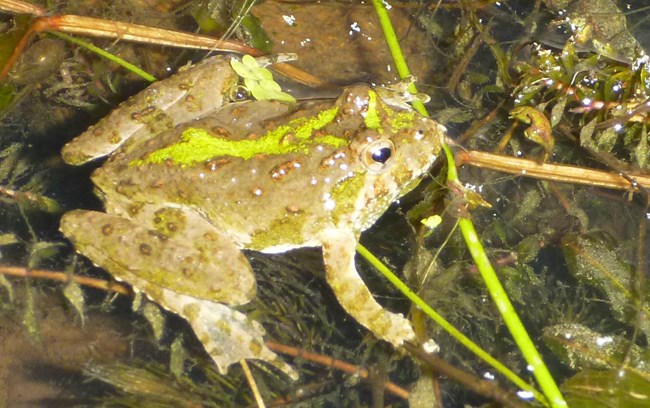Last updated: January 10, 2024
Article
Amphibian Monitoring on the Upper Mississippi River

Gary Casper
Toads and frogs are unique among amphibians in that they produce calls that are unique and identifiable. This makes it possible to monitor their populations using remote recorders, or “frog loggers.” Monitoring is important for many reasons, the top one being that declines of amphibian populations are one of the most prominent conservation issues in the world. Most amphibians need both land and water during their lifetimes, so they are sensitive to environmental changes including temperature, precipitation, and humidity, making them indicators of climate and habitat change.

NPS
Frog Loggers
Ten permanent amphibian monitoring sites were established in 2015. In April, an audio recorder at each site begins collecting 5-minute samples once an hour between 5:00 p.m. and 3:00 a.m. each day. Four extra samples are collected on the half-hour mark in the evenings between 7:30 and 10:30 p.m. A temperature sensor records temperature once an hour.
Recording frog and toad calls allows us to determine occupancy and abundance. Occupancy is a measure of whether or not a site is occupied by a species. Abundance is tracked by assessing how the maximum call intensity changes on sites across years, and by how many times we hear that species across years. In 2018, we also began tracking phenology, or the trends in annual first-calling dates for each species over time. For now, we are only tracking phenology for three species common to all parks in the network: Eastern American Toads, Green Frogs, and treefrogs. The Gray Treefrog and Cope’s Gray Treefrog have very similar calls that are difficult to distinguish, even with recordings, so for phenology purposes, we combine data for both species.
A sub-sample of the recordings are used to assign a Call Index Value (CIV) to each species. CIV is the maximum call intensity, ranging from CIV=1 (non-overlapping calls indicating few singing males) to CIV= 3 (calls too numerous to count individuals). CIVs can be analyzed over time to determine if a species is increasing or decreasing in abundance.
The Latest (as of 2019)
Eight of the nine species known to occur at MISS were found in 2019, the most well distributed being Eastern American Toad, Gray Treefrog, Green Frog, and Northern Leopard Frog. Rarer are Wood Frog (two sites), Cope’s Gray Treefrog (three sites), and Boreal Chorus Frog (three sites). Blanchard’s Cricket Frog was heard at just one site, but among Great Lakes Network parks, Mississippi River is the only place this species is found. This has spurred interest in others including the Minnesota Department of Natural Resources to look more closely for this species, and surveys outside of our monitoring efforts have located the cricket frog at several other sites along the river.
The Spring Peeper remains absent, as in all prior years. The American Bullfrog, also not yet detected at any of our monitoring sites, has been confirmed separately at Pigs Eye Lake. Mississippi River and Indiana Dunes are the only network parks where bullfrogs are known to occur.
Phenology
Frogs begin calling earlier at MISS than at most other network parks. In 2019, the Eastern American Toad was the first species heard, beginning on 23 April. Treefrog calls (both species were present) were heard in mid-May, with the earliest on 4 May. Green Frogs followed soon after, with calls starting in late May.
Call Index Values
All species scored a CIV=3 from at least one site except Blanchard’s Cricket Frog (maximum of CIV=2) and Wood Frog (maximum of CIV=1).

What's Next?
The automated recorders continue to turn on each spring and capture the sounds of frogs and toads coming out of their winter slumber and looking for mates. Data collected since 2019 are being analyzed and we will publish regular updates on the status of amphibians along the upper Mississippi River.
